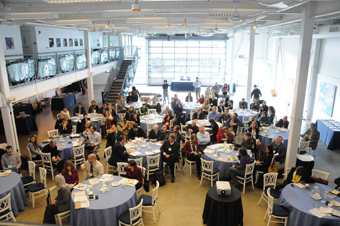
Join us in Boston, Dec. 8-9 @ the JFK Library!
Nicole Koharik, serves as the global sustainability marketing director for GOJO Industries, a global leader in hand hygiene and healthy skin and the inventor of PURELL® Hand Sanitizer. Koharik’s focus at GOJO includes corporate sustainability strategy, policies, goals and stakeholder engagement and reporting. GOJO was among the first organizations to pilot the Chemical Footprint Project, and Koharik will be speaking about the experience at BizNGO 2015.
Q: Why is it important for you to attend the BizNGO Conference?
Nicole Koharik: The focus on safe chemistry is and has always been a high priority for us here at GOJO. The company was founded when our co-founders Goldie and Jerry Lippman had the insight that people were using toxic compounds to clean their hands, and they wanted to find a safer and more effective way to clean hands. Fast forward to today and our strong commitment towards sustainability remains and is part of our GOJO Purpose: Saving Lives and Making Life Better Through Well-Being Solutions. We recognize the value of BizNGO in making safer chemistry the norm, versus something only the leaders do. We want to play a role in that.
Q: Why is measuring a company’s chemical footprint important in your area of hand hygiene and skin care products?
NK: We know effective hand hygiene and well-formulated hand hygiene products can reduce risk for illness and infection. As a socially responsible company, we formulate our products to effectively reduce germs, maintain and improve skin condition and be aesthetically pleasing. Additionally, our formulations are chemical based, so selecting safe and effective ingredients is an important part of the overall hand hygiene solution that we provide to our customers. The Chemical Footprint Project (CFP) has given us a helpful framework to guide the development of processes to evaluate our ingredients and categorize them. It’s given us a good structure to implement our sustainable chemistry policy, which we first established in 2013.
Q: What have you learned from BizNGO that has changed the way you operate?
NK: Participating in the CFP pilot last year has really driven value for our organization in terms of giving us a framework for implementing our sustainable chemistry policy and generating rich dialogue with both internal and external stakeholders. It also reinforced the significance of sustainable chemistry as a priority for our business, and accelerated dialogue across the company, from our leaders to our product management, regulatory, and marketing teams. We’ve had more strategic conversations about risk versus hazard, vulnerable populations, and science versus perception, for example.
Q: What was it like participating in the pilot for the Chemical Footprint Project?
NK: At first it was challenging because when we started looking at the questions as a team there was a need for a shared understanding on many levels. The tool and the framework itself were really helpful – it was a robust self-assessment, and that was valuable. It helped us move towards a whole systems approach verses the product by product approach we were taking. Now we’re proactively managing and measuring everything collectively.
Q: Do you see other companies in your sector following your lead?
NK: It’s interesting because in 2006 GOJO was the first to market an eco-label, green certified institutional hand cleaner and in 2010 we were the first to launch a green certified hand sanitizer, with PURELL® Green Certified Hand Sanitizer. We’ve seen others in our industry follow our lead in terms of product certification. This continues to be a priority for us, but with our engagement with the CFP, we’re taking on a whole systems approach to proactive management and measuring of chemicals. That’s something we haven’t seen from anyone else in our sector yet.
|
Register for the 2015 BizNGO-Chemical Footprint Project Conference! |
Q: Are you using your company’s movement toward green chemistry as part of your marketing efforts?
NK: Yes, definitely. We learned about the significance of sustainable chemistry to our customers and other external stakeholders when we conducted our materiality assessment. We worked with stakeholders to learn what matters most, and we learned that sustainable chemistry, including governance, the reduction of chemicals of concern and transparency, are key issues. That aligned nicely with our strategic focus as a company. It’s a priority for us to leverage this and be accountable to our stakeholders. We are looking forward to the next milestone on our sustainability journey and to sharing our 2020 goals.
Q: What do you see as the primary obstacles for companies in your sector transitioning to safer chemicals?
NK: Practically speaking there are two obstacles. The first is the issue of data gaps. Even though we use best-in class tools such as GreenScreen® for Safer Chemicals to assess ingredients, it’s not easy. Despite all of the information sources available, we still run into data gaps. Second, this transition requires a team effort. Manufacturers can’t do it alone. Having other like-minded collaborators is really important. This could be an obstacle if not everyone is there yet with the thinking, but so far we haven’t encountered any of this second obstacle. Everyone has received our commitment in this area very positively.
Q: Is there resistance from manufacturers in moving to safer chemicals?
NK: There are still challenges in getting data. We’ve always taken a collaborative approach to sustainability. We have suppliers who are part of our effort already so we tend to focus on those areas where we already have those relationships. I don’t see a shift yet, but as we get farther down the road there definitely will be.
Q: What do you hope will come out of this year’s BizNGO Conference for GOJO?
NK: One is building on the relationships with our stakeholders that will be there. I hope that having the opportunity to talk about our process and our progress will help open doors for stronger collaboration. Also last year I was on my own, but this year I’m bringing two colleagues from GOJO with me, so I’m excited to learn with them and bring back best practices to help achieve our goals. We see the intention of BizNGO as closely aligned with our Purpose and focus on delivering well-being solutions that benefit human health and the environment. As a leader in sustainability in our space, we see it as a great opportunity to be part of the industry transition to safer chemicals.
# # #



